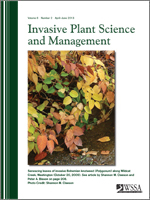Privet has escaped from cultivation and is invading natural areas throughout eastern North America. Understanding the pattern of invasion over time could help us develop more efficient management strategies. We studied the invasion history and spatial distribution pattern of privet by mapping age and spatial data for established patches in a 132-ha (326 ac) forested natural area in northeast Ohio. We determined the age of 331 geo-referenced patches by counting annual rings, and mapped them with corresponding land habitat. Age distribution and cumulative number of privet patches over about 40 yr showed three phases of invasion. The initial 19-yr lag phase was characterized as a dispersed spatial pattern (based on nearest neighbor analysis), with patches located mostly at edges of different habitats and open places. In a second phase of about 15 yr, an average of 19 patches were initiated yearly, in a pattern that trended towards clustered. The final phase began around 2007, as the rate of new patch establishment declined, possibly because of saturation of the suitable habitat. Establishment of new patches was not associated with specific habitats. Aggregation of patches with similar ages increased after 1998 and became significantly clustered. Mapping of clusters of old and young patches identified invasion hot spots and barriers. Results affirmed that the best time for invasive control is during the lag phase. By monitoring edge habitats associated with early establishment, managers might detect and control early invaders and delay the onset of the expansion phase.
Nomenclature: Privet, Ligustrum vulgare L
Management Implications: Invasive plants in natural areas are difficult to detect in early stages when control would be most effective. If managers knew where to expect initial establishment and the pattern of subsequent patch development, control strategies could be targeted more efficiently. In this study, we determined the age distribution and spatial pattern of patches of privet (Ligustrum vulgare), a woody invasive plant. We reconstructed the invasion history in a natural area in northeast Ohio where privet has escaped from home landscapes. Since the privet invasion is still in progress, understanding the history and pattern of the current invasion could provide insight into future spread. The oldest privet patch was dated to 1972, but significant increases in patch number did not begin until about 1991. Initial patches appeared mostly in edge habitats, but thereafter the distribution was more random and there was no clear invasion front related to topography or land use. Hot spot analysis suggested that the highly dispersed initial patches, which probably resulted from multiple random dispersals from one or more source populations, could have facilitated further invasion. The rate of new patch formation slowed around 2007, possibly because of saturation of suitable habitat. Results suggest that managers should monitor edge habitats to detect early privet invasion, and that a prolonged lag period provides time for early control efforts before rapid expansion occurs.





